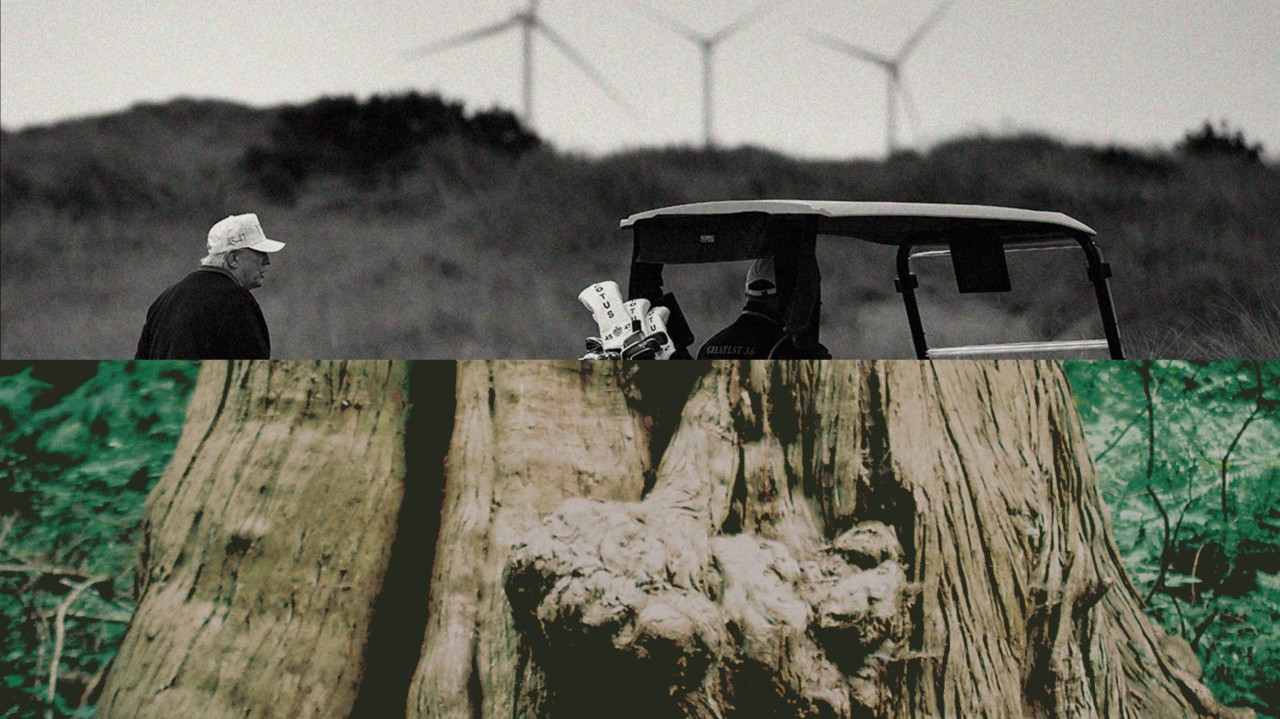

Getty Images / BRENDAN SMIALOWSKI Rachele Daminelli / Connected Archives
words by miranda green
Three years before Donald Trump would win his first presidential election, he furiously penned at least 16 separate letters in green ink decrying what he argued would be an eyesore and waste of money: offshore wind.
“The monstrous industrial machines that you want to litter all over the magnificent waters and shore … will destroy the environment and tourism sector,” Trump wrote in one 2013 letter to Scotland’s First Minister Alex Salmond, referring to an 11-turbine, offshore wind farm slated to be built 1.2 miles from Trump’s Aberdeenshire golf course in Scotland.
Trump battered the local Scottish government for years with complaints and lawsuit threats over the energy source that he argued would hurt tourism. He ultimately lost his legal battle. The wind farm was completed in 2018 and is expected to produce the equivalent of more than 70% of Aberdeen’s domestic electricity needs for the city of nearly 200,000 people.
But Trump’s ire toward the towering turbines festered, following him into the White House and across both presidencies. Last week, he made it clear that his hatred for the energy source had only petrified, calcified by time, but stronger than ever.
He posted the following on Truth Social August 20:
Three days later, the head of the Bureau of Ocean Energy Management announced it was halting work on an offshore wind project off the coast of Rhode Island that was 80% complete. The Revolution Wind Project was slated to bring clean energy to more than 350,000 homes in 2026.
Then, Transportation Secretary Sean Duffy last Friday terminated and withdrew $679 million in federal grants earmarked for 12 other wind projects in New Jersey, California, Virginia, and elsewhere.
“Thanks to President Trump, we are prioritizing real infrastructure improvements over fantasy wind projects that cost much and offer little,” Duffy wrote in a statement.
To environmentalists, clean energy advocates, electricity think tanks, and anyone in the renewables industry, the moves were drastic but not unexpected.
The Trump administration, its political donors, oil and gas executives, and many conservatives spent years building this momentum against wind energy.
This is their moment.
The White House put a stake in the ground on day one, issuing an executive order that placed a moratorium on all offshore wind construction.
“Particularly in the second administration, it’s really accelerated this opposition,” Nick Krakoff, senior attorney at the Conservation Law Foundation, told me. “It’s hypocritical that you know at the same time that they’re loosening regulations on fossil fuel interests on fossil fuel projects, that they’re increasing the regulation and increasing scrutiny of renewable projects, and targeting already permanent projects.”
Several federal agencies recently took steps that complicate wind-energy development. The IRS issued new guidance limiting access to federal tax incentives for wind and solar projects, while the Department of Commerce opened a probe into whether turbine imports pose national security risks. In April, the Department of the Interior paused the Empire Wind project off Long Island, with Interior Secretary Doug Burgum arguing it was approved too hastily by the previous administration.
I asked Krakoff who stands to benefit the most from canceling Rhode Island’s Revolution Wind—a nearly built, $6.3 billion project that was key to helping the state realize its net-zero goals and expected to bring substantial financial savings to nearby homes.
Krakoff said it was the oil and gas industry, which just so happens to be one of Trump’s largest donor blocs. New Englanders experience harsh winters, where gas is the predominant fuel source and electricity prices are rising rapidly. Wind as an alternative source could create significant savings for homeowners, as well as losses for the gas industry. Trump blamed renewables for the soaring prices. Studies say otherwise.
There are always detractors when something new is introduced, who are worried about how their lives might be negatively affected, and offshore wind has had its share of critics. Fifteen years ago, NIMBYies were a vocal and successful part of shutting down a proposed offshore wind project in Cape Cod.
Wind criticisms have since coalesced around a strikingly similar playbook, one drawing largely on misinformation and providing kindling for skeptics. These half-truths and believable lies lay dormant in an unknowing reader’s mind, ready to flare up when a political match is lit or presidential decree declared.
Researchers and journalists have revealed that many of the groups opposing offshore wind have taken money from the oil and gas industry—and that Trump himself has pushed some of the same false narratives that they reference. These accounts include unfounded arguments that offshore wind is responsible for mass die-offs of right whales or, my favorite, which Trump cites frequently: that wind is killing all of the birds. (Fun fact: The top bird killer in the U.S. is cats.)
While the administration puts on a full-court effort against wind, pushback has been equally as fierce.
Krakoff’s company filed an amicus brief in support of the lawsuit brought by 19 states and industry representatives against the Trump administration, challenging the January moratorium.
Construction on Long Island’s Empire Wind resumed in May due to a compromise with New York Gov. Kathy Hochul, who agreed to allow new gas pipeline construction in the state to move forward.
People connected to the fossil fuel industry would not be fighting this hard if they didn’t feel they had something to lose, a perspective shared by Michelle Solomon, manager of electricity at non-governmental organization Energy Innovation. Economically speaking, the market will continue to favor renewable energy in some capacity regardless of recent halts.
“Certainly solar will still feel impacts due to more stringent permitting from the federal government,” Solomon told me. “But I think that there’s still a lot of enthusiasm for clean energy. It’s still part of most affordable energy portfolios. It’s still very much present in utility-planning processes.”
Solar, wind, and battery projects are the cheapest sources of energy to build. Roughly 93% of new electricity resources in 2025 were projected to be wind, solar, and batteries, according to an Energy Information Administration report published in February of this year. And batteries will continue to be able to receive federal tax credits available, despite the recent elimination of similar credits for wind and solar.
With or without the current administration’s blessing, these technologies have already taken flight. Bird puns included.
Want me to look into The Understory of something? Send me an email!
Trump’s Blockage of Offshore Wind Was Years in the Making